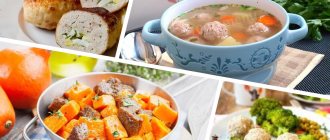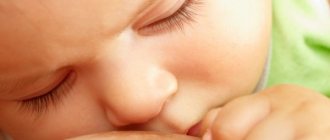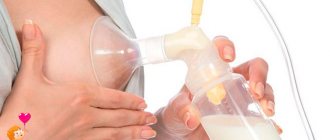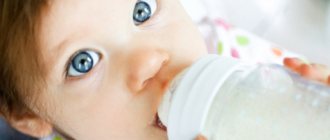When to introduce complementary foods to an allergic person?
Answer the question: Are there any manifestations of allergies at the time of starting complementary feeding?
- If yes, contact your pediatrician (allergist). Introducing complementary foods without consulting a doctor in this condition can worsen allergies. It is possible that the timing of the introduction of complementary foods will be individually shifted for the duration of treatment and stabilization of the condition, according to the doctor’s decision.
- If allergies are in the past, complementary foods are introduced from 4-6 months, but with some peculiarities. We start complementary feeding during remission. Remission is a period when allergy symptoms are absent for more than 1 month. Don't forget to consult your doctor in this case too.
- If the allergy first appeared during the introduction of complementary foods, read this article and contact your pediatrician.
How does a hypoallergenic diet differ from an elimination diet?
For allergic diseases, your doctor may recommend various types of diet:
- Elimination diet - when the allergenic product is known and it is excluded from the diet for a long period. This is the best option, but, unfortunately, identifying a specific allergen is very difficult.
- Hypoallergenic diet - it eliminates a number of foods with a high allergenic load.
Most often, a hypoallergenic diet is recommended. Currently, a hypoallergenic diet developed by the founder of Russian allergology, Andrei Dmitrievich Ado, is widely used.
A hypoallergenic diet helps reduce the symptoms of allergies and reduce the risk of their recurrence in the future.
This diet is recommended not only for people who have reactions to foods. It should also be followed in case of exacerbation of other types of allergies, as well as for children and pregnant women who are predisposed to allergic reactions. Also, a hypoallergenic diet is prescribed in cases where the allergen has not yet been identified. You need to stick to the diet constantly during exacerbations, and for preventive purposes - 2-3 weeks per season.
Which products to choose?
If the child has already established the causative factor of the allergy, it must be completely excluded.
Allergy is a serious disease that can be corrected primarily by diet. The first complementary food for children at risk of developing allergies should be:
- One-component
- Gluten free
- Dairy-free
- Sugarless
Study: connection between antibiotics and allergies in children
Almost everything in the world has two sides, and medications, alas, are no exception. All of them, even the most seemingly harmless and “natural” ones, exhibit side effects. The words of Paracelsus, spoken by him four hundred years before Fleming’s accidental discovery of penicillin, “All poison, all medicine,” reflect the real situation in pharmacology of the 21st century. This does not mean that we need to give up medications, but it is important to be aware of their side effects. And just recently, data has appeared indicating that one of the most popular groups of drugs that allow us to survive in the world of bacteria - antibiotics - has one significant drawback.
Scientists say
Information that has already alarmed both the scientific world and medical practitioners was published at the end of December 2021 in the major scientific journal Jama Pediatrics (1). The researchers conducted a large-scale analytical work: they studied 798,426 medical records of children born in 2001–2013. The subject of their attention was the prescription of antibacterial drugs of five classes, which are most often used in pediatrics - penicillins, penicillins in combination with β-lactamase inhibitors (clavulanic acid), cephalosporins, sulfonamides and macrolides. The researchers recorded all prescriptions of these classes of antimicrobial agents to infants from birth to six months of age, and then carefully reviewed the medical records of these children.
The results of the analysis showed that 16.7% of infants received antibacterial drugs: penicillins were most often prescribed, then in descending order: macrolides, cephalosporins, protected penicillins, and least often - in 3.8% of cases - sulfonamides.
Moreover, antibacterial drugs of all these groups were associated with allergic diseases in later life.
These include food allergies, asthma, atopic dermatitis, allergic rhinitis, allergic conjunctivitis, and contact dermatitis. In addition, an increase in the likelihood of an extremely dangerous allergic reaction, which is fatal in 10–20% of cases, has been recorded - anaphylaxis, or anaphylactic shock. The risk of developing allergies is highest after taking penicillins and least after taking sulfonamides. It has not yet been possible to accurately establish the cause-and-effect relationship between antibiotic therapy and allergic diseases. But scientists were able to describe the possible mechanism of the adverse reaction.
Alleged reasons
One of the factors that likely contributes to the increased risk of allergic diseases several years after the use of antibiotics and sulfonamides may be their negative impact on the microflora. It is known that antibacterial drugs do not work selectively, showing an effect against both pathogenic bacteria and beneficial microorganisms necessary for our immune system to protect against allergic or autoimmune diseases.
We are talking about both the “famous” intestinal microflora and the microbiome as a whole - after all, bacteria live not only in the digestive tract, but also on the skin, mucous membranes, biliary tract, genitourinary organs, lungs and other organs and systems. The death of beneficial bacteria during antibiotic therapy may start a pathological chain, disrupting important natural defense mechanisms against allergies.
It should be emphasized that this is a possible reason, not an obvious one. To more accurately determine why exactly the risk of allergies increases after the use of antibacterial agents, more than one research work will be needed. But regardless of the results of further research, the fact of another adverse reaction of this class of drugs is already obvious. The scale of the analysis is so large that its results cannot be doubted: unfortunately, infants under six months of age who received antimicrobial drugs belonging to one of the five pharmacological groups described are at increased risk for developing allergic diseases in later childhood and adolescence .
Possible consequences
Of course, the connection between antibiotic therapy and allergies is bad news. However, it should in no way be taken as a ban on the use of antibacterial agents for infants. Drugs in this group still remain the only effective protection against pathogenic microorganisms. They should be prescribed if there are indications for it.
The risk of not taking antibiotics and synthetic antimicrobial drugs can be much more significant for the health and even life of a child than the hypothetical probability of developing allergies in the future.
Information about the results of the study is important primarily for pediatricians prescribing antibacterial drugs. Physicians deciding whether to treat infants with antibiotics should weigh the risk/benefit ratio particularly carefully.
What remains for parents?
Trust the doctor and, if indicated, be sure to give the child the prescribed medications. If absolutely necessary, check the conclusion with the help of other doctors. But the main thing is to never self-medicate your child with antibiotics! Do not “prescribe” them to your baby yourself based on the results of reading various online articles and do not try to purchase them without a prescription. Take care of your health and the health of your family! Sources:
- Zven SE et al. Association Between Use of Multiple Classes of Antibiotics in Infancy and Allergic Disease in Childhood // JAMA pediatrics. — 2020; 174(2):199–200.
Marina Pozdeeva, pharmacist, medical journalist Photo depositphotos.com The author’s opinion may not coincide with the opinion of the editors
Rules for introducing complementary foods
- Introduce strictly one new product into your child’s diet.
- Start complementary feeding with single-ingredient products.
- Introduce a new product starting with 1/4-1/2 teaspoon per day.
- Daily increase the volume of the administered product by 2 times.
- Give complementary foods before breastfeeding or formula feeding. A hungry baby will try new flavors with great enthusiasm.
- Give a new complementary food in the first half of the day (to see possible intolerance reactions: regurgitation, vomiting, upset bowel movements or skin rash).
- After 7-10 days, the volume of complementary foods should reach the age norm.
- Give a new complementary food for 3-4 weeks before introducing the next one.
- Be sure to use a spoon so that the child learns to eat like adults.
- Complementary feeding is replacement in nature and replaces the volume of breast milk or formula that the baby receives.
- Assess the condition of the baby’s skin and digestion daily, and if it worsens, stop introducing the new product.
- Keep a “Food Diary” - record the amount, foods and the child’s reaction. This practice will allow you to formulate a diet for allergies and will help the doctor when prescribing treatment.
- Do not introduce complementary foods during the 3 days before and after preventive vaccinations.
- Give your baby special baby water
- Before introducing complementary foods, consult your pediatrician.
- Use commercially produced complementary foods (because cereals, vegetables and fruits for the production of baby food are carefully selected and undergo strict safety and quality control. Thanks to technological production processes, complementary foods acquire the optimal composition and consistency for absorption by the child’s digestive system.
Nutrition for children over three years old with food allergies
- home
- / Articles
- / Food allergies
print version
Most often, children suffering from food allergies are prescribed a nonspecific hypoallergenic diet. It is based on the exclusion from the diet of products with high sensitizing activity, products and dishes containing extractive substances and essential oils (meat, chicken, fish and mushroom broths, hot seasonings, garlic, radishes, radishes, raw onions, mustard, horseradish , pepper, salty foods), canned foods, food additives (colors, preservatives, emulsifiers, flavors), fruit essences (ice cream, pastries, cakes, carbonated drinks, chewing gum). At the same time, the diet must meet the requirements of rational nutrition - to maximally meet the physiological needs of the child in food ingredients and calories.
Dairy products and eggs. They have high nutritional value for a child, so these products cannot be completely excluded from the diet. Eggs should be included at least 1-2 times a week, hard-boiled. It should be remembered that the yolk of an egg is less allergenic than the white. Boil milk for at least 15 minutes before drinking, and also use fermented milk products, sour cream, cottage cheese, and low-fat cheeses. Fats. Vegetable oil is used, preferably refined (sunflower, olive, rapeseed), and butter in limited quantities. Meat. If you have an allergy to cow's milk, beef, veal, and beef liver are excluded from the diet, because. Cow's milk protein has antigenic affinity with bovine tissue products. It is recommended to use lean pork, rabbit, lamb, and turkey (if tolerated). The allergenic activity of various types of meat decreases during freezing and subsequent gradual thawing, soaking, and prolonged cooking. Meat from young animals is more allergenic. Cereals and dishes made from them. Buckwheat, oatmeal, pearl barley, corn, rice porridge (cooked in water), pasta (1-2 times a week) are recommended. Vegetables. Cabbage, turnips, zucchini, pumpkin, lettuce, cucumber (except greenhouse), potatoes, rutabaga, squash, eggplant. To reduce allergenicity, it is advisable to soak vegetables in cold water for 1-2 hours. Fruits, berries. Apples (Antonovka, white filling), blueberries, cranberries, plums, cherries, blueberries, lingonberries, gooseberries, pears. Fruits that are peeled, stored in the refrigerator, baked or in the form of compotes are less allergenic. Beverages. Tea not sweet, without fruit additives, mineral water. Compote of dried fruits and fresh fruits and berries recommended above. Bread. White, black, gray, croquette cookies.
Products
| Amount (g, ml) for children aged | |||
| 3-6 years | 7-10 legs | 11-14 years old | |
| Cereals | 40 | 50 | 70 |
| Pasta | 20 | 25 | 30 |
| Milk (boil for at least 15 minutes), kefir | 400 | 450 | 500 |
| Cottage cheese | 35 | 70 | 70 |
| Sour cream | 5 | 5 | 5 |
| Butter | 30 | 40 | 40 |
| Vegetable oil | 10 | 15 | 15 |
| Meat (beef) | 175 | 230 | 280 |
| Confectionery (cookies, biscuits) | 10 | 15 | 20 |
| Potato | 220 | 270 | 350 |
| Various vegetables | 120 | 160 | 200 |
| Fresh fruits | 150 | 200 | 250 |
| Wheat bread | 150 | 220 | 300 |
| Tea | 0,4 | 0,4 | 0,4 |
| Sugar | 45 | 50 | 50 |
If a hypoallergenic diet does not lead to positive results within 10 days or relapses of the disease occur, nutrition should be reviewed from an individual perspective.
The organization of therapeutic nutrition should take into account organ damage to the digestive tract. Meals should be frequent and small, up to 4-6 times a day. For constipation, you should increase your intake of foods rich in plant dietary fiber; preference should be given to bran and vegetables, especially zucchini, squash, and pumpkin. After eating, the child should not take a horizontal body position for 1-2 hours in order to improve the motor-evacuation function of the digestive tract and prevent reflux pathology. Patients with atopic dermatitis and pathology of the gastrointestinal tract should avoid physical activity that causes an abrupt increase in intra-abdominal pressure and worsens duodenal transport (weight lifting, sudden jumps, intense running). Contact with nonspecific chemical agents should be limited: when washing dishes for a child with atopic dermatitis, use unscented laundry soap and baking soda. The duration of the diet is set individually, depends on the severity of the manifestations of food allergies, the effectiveness of the treatment and ranges from 3 to 12 months. If causally significant allergens are identified, the patient is prescribed an individual hypoallergenic diet with the exclusion of foods that cause exacerbation of the disease and obligate allergens. The duration of the diet is set by the attending physician and is at least 1 month, and often it must be followed for 1 year or more.
Read more: What are food allergies? The article was prepared by: Dmitry BUZA, allergist-immunologist of the highest category, candidate of medical sciences, head of the allergy department of the 4th City Children's Clinical Hospital in Minsk.
It is important!
The first feeding differs for children with different body weights.
You can check your baby's height and weight here. If the baby's height and weight are normal, start with one-component vegetable purees:
- broccoli
- zucchini
- cauliflower
- pumpkin
If a child is behind in weight, then it is better to start complementary feeding with gluten-free, one-ingredient, dairy-free cereals:
- buckwheat
- rice
- corn
Low allergenic products:
- zucchini
- pumpkin
- cauliflower
- buckwheat
- rice porrige
- green apple
- pear
- turkey
- rabbit
Highly allergenic products:
- cow's milk
- goat milk
- whole cow protein foods
- beef
- eggs (white and yolk)
- wheat
- fish
- soybeans
- semolina
- honey
- citrus
- strawberry
- tomatoes
- nuts
- juices
- compotes
- tea, herbal teas
Fully or partially limited products
The diet for children with allergies involves the exclusion of products such as meat/fish/mushroom broths and dishes based on them. It is not allowed to consume waterfowl meat, fatty red meats, smoked meats, milk, sausages, chicken eggs, “red” fish and caviar of all types, citrus fruits, chocolate, sweets and flour products, seafood (shrimp, mussels, squid), sour cream, all salted and pickled foods, canned food, cream, sweet curds, cooking/animal fats, salty and fatty cheeses.
Excluded from the diet: sugar, jam, honey, confectionery, ice cream, sweets, jams. White rice, pasta, and semolina are subject to restrictions.
All seasonings (vinegar, ketchup, mayonnaise, mustard, horseradish), mushrooms, pineapple, eggplant, melon, butter dough and fruits/vegetables of red and orange color (red apples, tangerines, beets, tomatoes, oranges, strawberries, strawberries) are excluded from the diet , radish, carrots, radishes), nuts (hazelnuts).
The diet menu should not include foods that contain dyes and preservatives, fruit tea, fruit/vegetable juices from red/yellow berries, coffee, or sweet carbonated drinks.
Table of prohibited products
| Proteins, g | Fats, g | Carbohydrates, g | Calories, kcal | |
Vegetables and greens | ||||
| carrot | 1,3 | 0,1 | 6,9 | 32 |
| salad pepper | 1,3 | 0,0 | 5,3 | 27 |
| tomatoes | 0,6 | 0,2 | 4,2 | 20 |
Fruits | ||||
| oranges | 0,9 | 0,2 | 8,1 | 36 |
| bananas | 1,5 | 0,2 | 21,8 | 95 |
| pomegranate | 0,9 | 0,0 | 13,9 | 52 |
| grapefruit | 0,7 | 0,2 | 6,5 | 29 |
| lemons | 0,9 | 0,1 | 3,0 | 16 |
| mango | 0,5 | 0,3 | 11,5 | 67 |
| tangerines | 0,8 | 0,2 | 7,5 | 33 |
Berries | ||||
| grape | 0,6 | 0,2 | 16,8 | 65 |
| Red currants | 0,6 | 0,2 | 7,7 | 43 |
Nuts and dried fruits | ||||
| nuts | 15,0 | 40,0 | 20,0 | 500 |
| raisin | 2,9 | 0,6 | 66,0 | 264 |
Cereals and porridges | ||||
| white rice | 6,7 | 0,7 | 78,9 | 344 |
Confectionery | ||||
| jam | 0,3 | 0,2 | 63,0 | 263 |
| jam | 0,3 | 0,1 | 56,0 | 238 |
| candies | 4,3 | 19,8 | 67,5 | 453 |
| pastry cream | 0,2 | 26,0 | 16,5 | 300 |
Ice cream | ||||
| ice cream | 3,7 | 6,9 | 22,1 | 189 |
Cakes | ||||
| cake | 4,4 | 23,4 | 45,2 | 407 |
Chocolate | ||||
| chocolate | 5,4 | 35,3 | 56,5 | 544 |
Raw materials and seasonings | ||||
| mustard | 5,7 | 6,4 | 22,0 | 162 |
| ketchup | 1,8 | 1,0 | 22,2 | 93 |
| mayonnaise | 2,4 | 67,0 | 3,9 | 627 |
| honey | 0,8 | 0,0 | 81,5 | 329 |
| vinegar | 0,0 | 0,0 | 5,0 | 20 |
Dairy | ||||
| condensed milk | 7,2 | 8,5 | 56,0 | 320 |
| cream | 2,8 | 20,0 | 3,7 | 205 |
| sour cream 30% | 2,4 | 30,0 | 3,1 | 294 |
| sour cream 40% (fat) | 2,4 | 40,0 | 2,6 | 381 |
Cheeses and cottage cheese | ||||
| cheese | 24,1 | 29,5 | 0,3 | 363 |
| dor blue cheese | 21,0 | 30,0 | 0,0 | 354 |
| blue cheese | 17,6 | 31,0 | 1,8 | 363 |
| amber processed cheese | 7,0 | 27,3 | 4,0 | 289 |
| cottage cheese 18% (fat) | 14,0 | 18,0 | 2,8 | 232 |
Meat products | ||||
| pork | 16,0 | 21,6 | 0,0 | 259 |
| pork fat | 1,4 | 92,8 | 0,0 | 841 |
| salo | 2,4 | 89,0 | 0,0 | 797 |
| mutton | 15,6 | 16,3 | 0,0 | 209 |
Sausages | ||||
| smoked sausage | 16,2 | 44,6 | 0,0 | 466 |
| smoked sausage | 9,9 | 63,2 | 0,3 | 608 |
| sausages | 10,1 | 31,6 | 1,9 | 332 |
| sausages | 12,3 | 25,3 | 0,0 | 277 |
Bird | ||||
| smoked chicken | 27,5 | 8,2 | 0,0 | 184 |
| duck | 16,5 | 61,2 | 0,0 | 346 |
| smoked duck | 19,0 | 28,4 | 0,0 | 337 |
| goose | 16,1 | 33,3 | 0,0 | 364 |
Eggs | ||||
| chicken eggs | 12,7 | 10,9 | 0,7 | 157 |
Fish and seafood | ||||
| fried fish | 19,5 | 11,7 | 6,2 | 206 |
| smoked fish | 26,8 | 9,9 | 0,0 | 196 |
| salted fish | 19,2 | 2,0 | 0,0 | 190 |
| Red caviar | 32,0 | 15,0 | 0,0 | 263 |
| black caviar | 28,0 | 9,7 | 0,0 | 203 |
| canned fish | 17,5 | 2,0 | 0,0 | 88 |
| semi-finished fish products | 12,5 | 6,7 | 14,7 | 209 |
| sardine | 20,6 | 9,6 | — | 169 |
| mackerel | 18,0 | 13,2 | 0,0 | 191 |
| cod (liver in oil) | 4,2 | 65,7 | 1,2 | 613 |
Oils and fats | ||||
| creamy margarine | 0,5 | 82,0 | 0,0 | 745 |
| coconut oil | 0,0 | 99,9 | 0,0 | 899 |
| palm oil | 0,0 | 99,9 | 0,0 | 899 |
| rendered beef fat | 0,0 | 99,7 | 0,0 | 897 |
| cooking fat | 0,0 | 99,7 | 0,0 | 897 |
| rendered pork fat | 0,0 | 99,6 | 0,0 | 896 |
Alcoholic drinks | ||||
| vodka | 0,0 | 0,0 | 0,1 | 235 |
Non-alcoholic drinks | ||||
| cola | 0,0 | 0,0 | 10,4 | 42 |
| black coffee | 0,2 | 0,0 | 0,3 | 2 |
| Pepsi | 0,0 | 0,0 | 8,7 | 38 |
| sprite | 0,1 | 0,0 | 7,0 | 29 |
| tonic | 0,0 | 0,0 | 8,3 | 34 |
| energy drink | 0,0 | 0,0 | 11,3 | 45 |
Juices and compotes | ||||
| cranberry jelly | 0,0 | 0,0 | 13,0 | 53 |
| * data is per 100 g of product | ||||
The procedure for introducing complementary foods for allergies
Monitor your baby at each stage of introducing complementary foods. If complementary foods are well tolerated, move on to the next product, in accordance with the general procedure for introducing complementary foods. After introducing 2-3 flavors of one type of complementary food, you can try to combine several types, the reaction to which was previously adequate. If signs of an allergy appear, stop introducing complementary foods.
1-4 months At this age, the child is fed exclusively on breast milk or infant formula. It is too early to introduce any types of complementary foods at this age. The optimal period for introducing complementary foods is considered to be from 4 to 6 months.
4-5 months One-component puree of white and green vegetables is the optimal first food dish. Add one type of puree first, then another. It is not recommended to mix the puree at this stage. You must know exactly the cause of a possible allergy. Monitor the child's reaction; if everything is fine, you can try giving the following vegetable puree from the list above. After introducing 2-3 flavors, you can try combining purees, the reaction to which was adequate.
5-6 months If everything went well at the stages of vegetable purees, the child’s diet for allergies is expanded - dairy-free, one-ingredient gluten-free porridges are added.
After introducing 2-3 types of such cereals, you can try combining cereals, the reaction to which was good.
At the same time, you can introduce a one-component meat puree, such as
- rabbit
- idea
It is better not to give beef puree to children at risk of developing allergies. During this period, you can add a small amount (1 teaspoon) of vegetable oil, for example, to porridge.
8-9 months If the previous stages went satisfactorily, try introducing green and yellow fruit purees, e.g.
- green apple
- pear
- banana
During this period, you can begin to introduce children's fermented milk products. As an alternative to baby kefir, try baby fermented milk formulas, for example, Nutrilak premium Fermented milk.
Fermented milk formulas are produced on the basis of regular infant formulas. They are easily digestible and have all the beneficial properties of fermented milk products.
10-12 months If the previous stages went well and did not cause allergies, you need to consult a doctor and then introduce complementary foods according to the general table.
Hypoallergenic diet for children over 3 years old
The older the child gets, the easier it is for the body to fight allergens. The diet for allergies in children 3 years old becomes even more varied. Especially if the child is not allergic to wheat flour. At this age, you can introduce regular and lazy dumplings, homemade dumplings, and pastries into your diet. If gluten is intolerable, then all this can be prepared from corn or buckwheat flour.
By this age it is already known whether cow's milk is tolerated. New vegetables and berries also continue to be introduced into the diet. Soups, casseroles, stews and other dishes become even more varied and tastier; the whole family can eat these dishes.
What to feed your baby:
- various cereals. You can add steamed pumpkin, baked apples, cook with other hypoallergenic berries and fruits;
- casseroles. Not necessarily from cottage cheese. You can add cereals, pasta, dried fruits and even vegetables;
- meatballs, cutlets, meatballs. Minced meat products can be present in main courses, soups, casseroles;
- vegetable purees. You don't have to use only potatoes. It’s worth paying attention to zucchini, cauliflower, and broccoli, it’s time to focus on pumpkin and carrots. Mixed purees have very interesting flavors;
- soups. Their types also change. You can cook creamy dishes using vegetable and meat broths. Sometimes children from the age of three are given white fish;
- baking. Cookies, flatbreads, and buns for children are prepared without sugar and with a minimum amount of fat. Fried pancakes and pies should still be avoided. But sometimes you can bake from the oven.
Based on these dishes, a hypoallergenic diet is built for children 3 years old; more fresh vegetables and fruits are introduced into the menu. Fiber helps remove allergens, normalizes stool, and cleanses the body from the inside.
What does the menu for one day look like:
- Breakfast: porridge with or without milk, depending on the reaction, apple.
- Afternoon snack: pumpkin puree, compote.
- Lunch: soup with meatballs and noodles, buckwheat porridge with meat, compote, fresh cucumber.
- Afternoon snack: pear or other fruit.
- Dinner: mashed potatoes, cutlets, grated carrots.
- Second dinner: cottage cheese or other fermented milk product.
Why doesn't the hypoallergenic diet work?
- the true allergen may not have been determined
- perhaps allergy symptoms (usually skin) are not related to the food allergen at all
Often parents think that a small amount of allergen will not harm the baby: “Let him get used to it.” Do not do it this way! Even a small dose of an allergenic product will make the diet useless: the child will need about 3 weeks to recover from an allergic reaction. During the manifestation of an allergy, you will not be able to adequately assess the baby’s diet and identify the true allergen or introduce new complementary foods. Be patient, your baby will still have time to try all the flavors and products. He has his whole life ahead of him and it would be better if it were allergy-free.
What to feed a child with allergies. Doctor's advice
How to make life easier for children with allergies? What can you eat and what should you avoid? Are allergies inherited? Allergist-immunologist Elena Antsiferova told the Moscow 24 portal about all this.
Photo: depositphotos/oksun70
– Can we say that sweets are the most common children’s allergen? – Specifically, sweet foods – no, but they often contain many different additives that can provoke allergies. The most common food allergies in preschoolers are chocolate, nuts, citrus fruits and fish.
– What other foods should children with allergies be wary of? – The child’s parents usually know what foods their child is allergic to. But there are also so-called obligate or obligate allergens, many of which provoke an allergic reaction in most people predisposed to allergies.
Usually these are red and orange foods: tomatoes, carrots, red and orange peppers, strawberries, raspberries, persimmons, dried apricots. Next come citrus fruits - usually oranges and tangerines, less often grapefruits. Coffee, cocoa and, of course, sweets and chocolates.
Photo: portal Moscow 24/Lidiya Shironina
This list continues with such popular allergens as fish, seafood, eggs, milk, as well as honey, seeds and nuts. Don't forget about various preservatives and dyes.
The most common food allergies in preschoolers are chocolate, nuts, citrus fruits and fish. Elena Antsiferova,
PhD, pediatrician, allergist-immunologist, head of the “Eva Doctor” school
– You can’t have so many things? What products then can be included in the menu for allergy sufferers? – These are products that are not bright, but white-green in color. You can try including yellow vegetables and fruits in your diet.
So, what is possible: zucchini and zucchini, all types of cabbage (broccoli, Brussels sprouts, kohlrabi, cauliflower), cucumbers, green apples, pears, peaches, bananas, plums, white currants. It is very important that vegetables and fruits are grown without harmful additives.
Photo: portal Moscow 24/Lidiya Shironina
During cooking, you can add leeks and onions to your dishes. You can try to include in your diet: light-colored pumpkin, green beans, and green peas if tolerated. Fermented milk products are usually well tolerated. It is important not to forget about a sufficient amount of meat in the diet of children.
There is another interesting rule according to which a person is recommended to eat fruits and vegetables grown specifically in his climate. A passion for exotic fruits and vegetables can be fraught with the development of allergies.
A person is recommended to eat fruits and vegetables grown specifically in his climate. A passion for exotic fruits and vegetables can be fraught with the development of allergies. Elena Antsiferova,
PhD, pediatrician, allergist-immunologist, head of the “Eva Doctor” school
– And if the child is healthy, does he still need to follow a hypoallergenic diet? - Of course not! A healthy child can eat anything, but eat it reasonably. Children should not be given the opportunity to abuse allergenic foods. Therefore, for example, eating 10 tangerines or a box of chocolates in a row can “wake up” an allergy.











